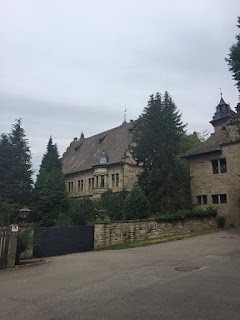Architecture
The castle in the style of the Renaissance is a powerful, closed four-wing building with six storeys. On its northwestern corner stands the Romanesque donjon of the former castle. Two other corners are occupied by high circular towers. A bridge leads to the entrance, with the arms of the Ludwig Casimir von Hohenlohe and his wife Anna von Solms-Laubach is decorated.
The Castle Museum
During a visit of the Castle Museum can, among other things the Imperial Hall, the royal vault and the late medieval and fully functional castle kitchen - everything is still largely in its original state - to the public.
In addition to historically valuable objects hunting weapons and trophies are issued. However centerpiece of the museum is the art and rarities cabinet. It shows works of art from the Renaissance as well as curios and memorabilia; including a hat of the Swedish king Gustav II. Adolf, a shoe of Tsarina Catherine the Great and a nearly fist-sized stone in the bladder of the Counts of Nimburg.
History
The roots of today's castle are in a Staufer Wasserburg to seek the early 13th century. She stood on a sandbar in a swampy area near an old trade route that from the Rhine via Wimpfen east to the Danube led.
Around 1230, the plant was owned by the Lords of Stein, whose descendants later "Neuenstein" called, and came in 1300 to the Counts of Hohenlohe, who used the castle as a residence. For the construction and supply of the castle and the castle played the Eschelbacher platforms as transport an important role.
After the plant in the 15th century had already been extended, Count Ludwig Casimir von Hohenlohe them from the 16th century Heilbronner builder Balthasar Wolff remodel to a castle in the Renaissance style. The expansion lasted until the early 17th century.
After Wolfgang Julius von Hohenlohe had passed away in 1698, the family moved its residence to Öhringen. Neuenstein Castle stood empty and subsequently fell into disrepair. Later it served as a penitentiary and workhouse, as a nursing home and orphanage.
From 1870 renovations were carried out in the Imperial Hall to there then with a collection of antiques from the Schloss Kirchberg to lay the foundation for a family museum of the House of Hohenlohe. It was one of the first private museums in Germany and available from 1878 to the public.
Prince Christian Kraft zu Hohenlohe commissioned at the beginning of the 20th century the castle architects and researchers Bodo Ebhardt with a comprehensive restoration of the castle. The work took place in between 1906 and 1925th In its wake, the plant has been increased by a projectile. After the expropriation of the Silesian residence Schloss Sławięcice 1945 and the sale of castles Kirchberg and Ingelfingen 1952 and Öhringen, 1961 (as well as the hunting lodge Friedrichsruhe 2005) the New Stone castle is now also a museum and residence of the owner, force Fürst zu Hohenlohe-Oehringen (* 1933) ,























No comments:
Post a Comment